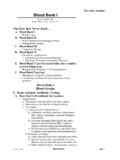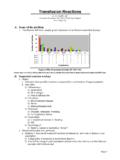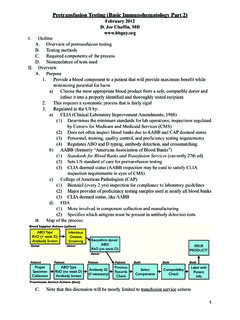Transcription of The Osler Institute Blood Bank I
1 The Osler Institute P}Chaffin (12/28/11) Blood bank I page 1 Blood bank I D. Joe Chaffin, MD Bonfils Blood Center, Denver, CO The Fun Just Never A. Blood bank I Blood Groups B. Blood bank II Blood Donation and Autologous Blood Pretransfusion Testing C. Blood bank III Component Therapy D. Blood bank IV Transfusion Complications * Noninfectious (Transfusion Reactions) * Infectious (Transfusion-transmitted Diseases) E. Blood bank V (not discussed today but available at ) Hematopoietic Progenitor Cell Transplantation F. Blood bank Practical Management of specific clinical situations Calculations, Antibody ID and no-pressure sample questions Blood bank I Blood Groups I.
2 Basic Antigen-Antibody Testing A. Basic Red Cell-Antibody Interactions 1. Agglutination a. Clumping of red cells due to antibody coating b. Main reaction we look for in Blood Banking c. Two stages: 1) Coating of cells ( sensitization ) a) Affected by antibody specificity, electrostatic RBC charge, temperature, amounts of antigen and antibody b) Low Ionic Strength Saline (LISS) decreases repulsive charges between RBCs; tends to enhance cold antibodies and autoantibodies c) Polyethylene glycol (PEG) excludes H2O, tends to enhance warm antibodies and autoantibodies. 2) Formation of bridges a) Lattice structure formed by antibodies and RBCs b) IgG isn t good at this; one antibody arm must attach to one cell and other arm to the other cell.
3 C) IgM is better because of its pentameric structure. Pathology Review Course page 2 Blood bank I P}Chaffin (12/28/11) 2. Hemolysis a. Direct lysis of a red cell due to antibody coating b. Uncommon, but equal to agglutination. 1) Requires complement fixation 2) IgM antibodies do this better than IgG. B. Tube testing 1. Immediate spin phase a. Mix serum, 2-5% RBC suspension; spin 15-30 sec. 1) Most common: 2 drops serum, 1 drop RBCs. b. Antibodies reacting here are usually IgM 2. 37 C phase a. Add potentiator (+/-), incubate at 37 C, spin. b. Potentiators and incubation times: 1) 10-15 minutes for LISS 2) 15-30 minutes for albumin or PEG 3) 30-60 minutes for no potentiation 3.
4 Indirect antiglobulin ( antihuman globulin ) phase a. Wash above to remove unbound globulins. b. Add antihuman globulin, spin. C. Alternatives to tube testing 1. Column agglutination technology (Gel testing) a. Add RBCs and plasma to top of tube, incubate, spin. b. Microtubes are filled with gel particles and anti-IgG 1) Anti-IgG grabs onto IgG-coated RBCs and inhibits their migration through gel immunologically 2) Gel particles separate RBC clusters physically (inhibit agglutinates from migrating through gel). c. Results: 1) Negative: RBCs form button at bottom of microtube. 2) Positive: RBCs stopped in areas through the microtube (more positive = higher position in tube) d.
5 Can be automated (ProVue machine) e. Similar sensitivity to PEG tube testing 2. Solid-phase Red Cell Adherence Testing a. Antibody binds to lysed or intact RBC antigens that are bound by manufacturer to the sides of microwells b. Add patient serum, incubate, wash: If positive, antibody binds to test RBCs. c. Indicator RBCs (coated with monoclonal anti-IgG) attach to antibody on test RBCs. d. Spin and interpret 1) Negative: RBCs in a button at bottom of microwell, (indicator cells didn t bind to the test RBCs). 2) Positive: RBCs spread in a carpet all along the microwell (indicator cells did bind to test RBCs). e. Can be automated (Galileo, Galileo Echo, NEO) f.
6 Similar sensitivity to PEG tube testing The Osler Institute P}Chaffin (12/28/11) Blood bank I page 3 D. The Antiglobulin Test ( Coombs Test ) 1. Indirect: see above; demonstrates in-vitro RBC coating with antibody and/or complement. 2. Direct: red cells from patient washed, then mixed with antihuman globulin; demonstrates in-vivo RBC coating with antibody and/or complement. 3. IAT variations a. Unknown antibody check: Use RBCs with a known antigen profile, as in an antibody screen b. Unknown RBC antigen check: Use serum with known antibody specificity, as in RBC antigen testing c. Can be used to check for an unknown antigen OR unknown antibody, as in the crossmatch procedure 4.
7 Specificity possibilities for the antiglobulin a. Anti-IgG, -C3d ( polyspecific ); most common to start 1) Detect red cells coated with either of the above 2) May also detect other immunoglobulins (because the anti-IgG detects light chains, too) b. Anti-IgG and anti-IgG (heavy chain-specific) 1) Both detect IgG-coated red cells 2) Anti-IgG used for PEG, gel, and solid phase tests c. Anti-C3b, -C3d 1) Detects either of the above complement components 2) Most useful in evaluating IgM-related hemolysis, cold agglutinin disease 5. IgG-sensitized RBCs ( Coomb s control , check cells ) a. Use after negative DAT or IAT tube test (not gel or solid-phase) to ensure functioning of AHG reagent b.
8 Add IgG-coated cells to AHG-cell mixture c. Negative = bad AHG or no AHG added d. Other errors ( , omitting test serum) missed. E. Dosage 1. Some antibodies react more strongly with RBC antigens that have homozygous gene expression. 2. For example, imagine a hypothetical anti-Z a. Patient 1 genotype: ZZ (Homozygous for Z) b. Patient 2 genotype: ZY (Heterozygous for Z) Pathology Review Course page 4 Blood bank I P}Chaffin (12/28/11) c. If anti-Z shows dosage, it will react stronger with patient 1 s RBCs (see below). RBC Genotype Reaction with anti-Z ZZ 3+ ZY 1+ 3. Most common in Kidd, Duffy, Rh and MNS systems F. Enzymes 1. Proteolytic enzymes ( , ficin, papain) cleave RBC surface glycoproteins and can strengthen reactions by enhancing antigen expression or allowing antibodies to bind better to previously shielded antigens 2.
9 Enzymes may also directly destroy other antigens 3. Useful in antibody identification to confirm or refute a particular antigen as target of an antibody (see table) 4. The Enzyme Classification Enhanced Decreased Unaffected ABO-related ABO, H Systems Lewis System I System P System Rh System Kidd System MNS System Duffy System Lutheran System Kell System Diego System Colton System G. Neutralization 1. Certain substances, when mixed with a red cell antibody, inhibit the activity of that antibody against test red cells. 2. Some of these are pretty weird! (See table below) Neutralization of Antibodies ABO Saliva (secretor) Lewis Saliva (secretor for Leb) P1 Hydatid cyst fluid Pigeon egg whites Sda Human urine Chido, Rodgers Serum H.
10 Lectins 1. Seed/plant extracts react with certain RBC antigens 2. Especially useful in polyagglutination (T, Tn, etc) 3. May be commercial or homemade Lectin Specificity Dolichos biflorus A1 Ulex europaeus H Vicia graminea N Arachis hypogea T Glycine max T, Tn Salvia Tn The Osler Institute P}Chaffin (12/28/11) Blood bank I page 5 II. Blood Groups A. General characteristics 1. Definition a. Blood group antigen: Protein, glycoprotein, or glycolipid on RBCs, detected by an alloantibody 1) NOTE: Antigens are not limited to RBCs b. Blood group system: Group of Blood group antigens that are genetically linked (30 total systems per ISBT) 2. Significance a.


